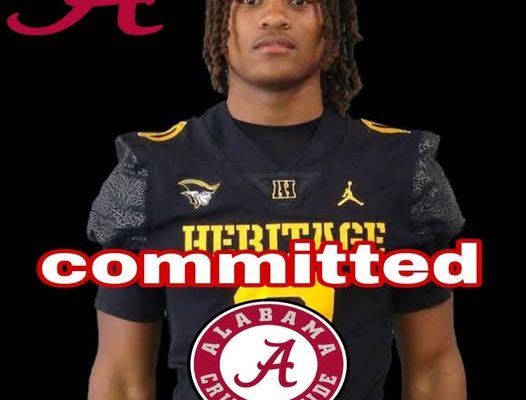For college football fans, recruitment season is a time of excitement, speculation, and high stakes drama. Nowhere is that more true than when the nation’s No. 1 high school football recruit makes his final decision. This summer, that climactic moment arrived when the top-ranked prospect—the kind of generational talent programs dream of—announced his commitment to the University of Alabama, choosing the Crimson Tide over powerhouse rivals Tennessee and Florida.
The announcement came like a shockwave across the college football landscape: a nationally televised ceremony in the player’s high school gym, flanked by a line of hats from Alabama, Tennessee, Florida, and Georgia. Cameras captured the moment: the Las Vegas lights glinting off the hats, the cameras rolling, the crowd leaning forward, hearts pounding. Then the hush, and the recruit stood and reached for the crimson cap—Alabama. The moment was electric. Alabama had landed a player described by recruiting analysts as “a generational talent… a program‑changer” (
Standing at 6‑4 and weighing 235 pounds, the multi‑position phenom delivered a speech that spoke volumes: “Each of these programs showed me love and gave me something to think about. But at the end of the day, Alabama felt like home. I trust Coach DeBoer and the staff to help me reach my full potential—on and off the field.” His declaration capped a debate that had simmered all spring and early summer.
Tennessee and Florida had both made powerful pushes. Tennessee, building momentum under Josh Heupel, had extended an early and consistent courtship and had the backing of in‑state fan fervor. Florida leveraged its storied legacy and new NIL infrastructure to mount a late offensive. But Alabama’s pitch was a familiar one: a legacy of player development, a pipeline to the NFL, and the kind of culture that keeps recruits hooked. It brought back untouchable memories of Nick Saban’s reign—even in the post‑Saban era, the Tide’s brand of excellence remained irresistible (
That appeal bridges eras. Alabama’s hand in shaping NFL stars is undeniable. When asked, the recruit’s father spoke about more than just football: “They talked about life after football. Education. Mentorship. Network. They made us feel like family.” That balance—elevating football performance while preparing for life beyond the gridiron—was decisive (.
This wasn’t a one‑off coup. It reflected a pattern of elite prospects choosing Alabama over SEC rivals. Not long ago, five-star wide receiver Malik Thompson, the No. 10 player in the country and second‑ranked WR prospect, chose Alabama over Florida, Texas, and Tennessee during a televised announcement (. Thompson’s words echoed the new recruit’s: “Alabama felt like home. The tradition, the coaching staff, the competition—it was everything I want as I prepare for the next level.” Their decisions weren’t just about convergence of talent—they were affirmations of a program doing something right.
This newest commitment is seismic. It instantly fortifies Alabama’s 2025 class—a class already boasting several five-star prospects. It sends a message to the rest of the country, and especially to SEC rivals: Alabama is still top of the food chain. According to recruiting analysts who tracked the moment, this signing sends shockwaves through Tennessee, Florida, Georgia, and beyond).
In Tennessee and Florida circles, disbelief soon gave way to strategic recalibration. Tennessee, which had been viewed as a potential frontrunner, saw its hopes dashed at the last moment. Its pitch—rooted in hometown comfort and Heupel’s vision—fell short. Florida poured resources into its recruitment, but found itself outmatched by Alabama’s developmental promise and football pedigree.
The ripple effects extend into recruiting itself. This commitment boosts Alabama’s own recruiting momentum, potentially attracting other top-tier players who will gravitate toward the recruiting powerhouse. DeBoer—still relatively new to Tuscaloosa—sees this as a validation of the program’s continued allure. As one Alabama assistant coach put it, “Coach DeBoer’s energy is infectious… At the same time, we still carry the Alabama brand, which is as powerful as ever”
The recruit’s choice transcends a seasonal whim—it reaffirms Alabama’s place at the apex of college football in the post‑Saban era. Even without its legendary figurehead, the Tide have maintained national dominance in recruiting, championship contention, and NFL pipeline production.
More than just a name, this recruit is a difference-maker. His elite combination of size, speed, intelligence, and position versatility places him in comparison territory with current NFL stars—Myles Garrett, Trevor Lawrence, Julio Jones. Scouts stress he’s a “franchise-changer” whose arrival will likely elevate both Alabama’s performance and its national perception
Beyond football, the committed recruit brings leadership potential at Alabama. He’s expected to enroll early, participate in spring ball, and serve as a bridge between the current squad and the next generation. With eyes already on college championships, he could be the centerpiece of DeBoer’s long-range quarterbacking plan—or could even influence the position group designation depending on team needs.
Inside the Tide’s locker room, veteran players welcomed him. One upperclassman told teammates, “This kid can play. Hard not to feel that hype.” Coaches—particularly those who helped in the late push—were elated. They feel he will help anchor an already strong rolling wave of talent.
The SEC rivals, meanwhile, must pivot. Kentucky, Missouri, South Carolina—they’ve all benefited from occasional Alabama recruiting missteps. But rival horizons dim when Alabama secures the flagships. Tennessee had to shift its approach to other top-tier targets. Florida doubled down on NIL offers and staff acceleration to avoid a narrative of “always close but never enough.” Georgia, traditionally strong, saw its chances compromised—its national allure now battles an Alabama gravitational pull.
Alabama’s win—even post‑Saban—underscores a reality: legacy matters. Recruits want NFL track records and winning tradition. They want coaching staffs that build both athletes and people. Alabama, under DeBoer, continues to deliver.
What happens now? The recruit will return to high school camp with renewed attention. Rivals will zero in on his senior-year performance and state playoff run. Alabama boosters and fans are already buying early jerseys, tweeting support, and planning campus visits. DeBoer’s staff will integrate him immediately—spring ball may be pivotal.
Alabama’s recruiting class—already ranked in the top three nationally—is set to climb higher. DeBoer’s signing of this No. 1 recruit, plus other five-stars like Xavier Griffin on defense and standout O-linemen, keeps Alabama competitive against national heavyweights like Georgia, Ohio State, and Texas
Still, the story isn’t over. February’s signing day remains pivotal, and recruiting remains fluid until ink dries. But the former top overall recruit has spoken, and the Tide’s banner flies high once again.
As kickoff approaches next fall, analysts will watch how this latest star develops in the Crimson Tide environment. Alabama’s gamble is clear: money, tradition, development, family culture. Tennessee and Florida understood that. They fought hard—and lost.
In the world of college football’s premier stage—the SEC—the story is truth: the No. 1 recruit has chosen Alabama. It’s not just a win in a recruitment ranking. It’s a declaration: Alabama’s dynasty isn’t over. It’s evolving—and at its center now stands the nation’s top high school football player.



